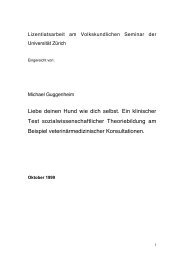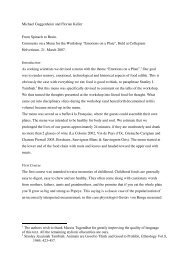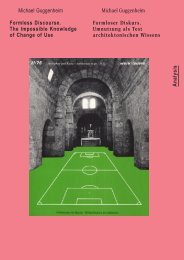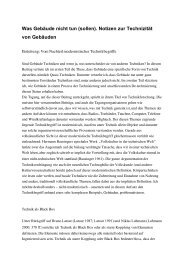The Laws of Foreign Buildings: Flat Roofs and Minarets - Michael ...
The Laws of Foreign Buildings: Flat Roofs and Minarets - Michael ...
The Laws of Foreign Buildings: Flat Roofs and Minarets - Michael ...
Create successful ePaper yourself
Turn your PDF publications into a flip-book with our unique Google optimized e-Paper software.
Guggenheim 7<br />
Figure 1. Photograph <strong>of</strong> the Piazza <strong>of</strong> Ascona around 1910, photographer unknown (from<br />
Keller, 2001: 13).<br />
built in a ‘Stil del Paese’ a version <strong>of</strong> a 19th century style from northern Italy (Keller<br />
et al., 2001, 18) (see Figure 2).<br />
When in 1928 the architect Eduard Keller from the German-speaking part <strong>of</strong> Switzerl<strong>and</strong><br />
applied for a building permission for his own little modernist vacation house, Casa<br />
Catterina, the building authorities <strong>of</strong> Ascona were alarmed. <strong>The</strong>y asked the lawyer Otto<br />
Maraini to write an expertise about the new buildings. Maraini noted the ‘laudable intention’<br />
that the ‘so called rational way <strong>of</strong> building’ tried to express the ‘purest <strong>and</strong> most<br />
pristine’ facets <strong>of</strong> buildings <strong>and</strong> he maintained that the new ways <strong>of</strong> building ‘logically<br />
implicate new aesthetic forms’ (Keller et al., 2001: 20, 22). However, he concluded that<br />
the buildings under review ‘do not respect the local character <strong>and</strong> its traditions’ (Keller<br />
et al., 2001: 22). He wrote: ‘It is Nordic import’, which,<br />
carries an expression, form <strong>and</strong> character that is not acceptable here <strong>and</strong> that st<strong>and</strong>s beyond<br />
doubt in contrast to the spirit <strong>of</strong> article 1 §2 <strong>of</strong> the building code that states that the town<br />
administration has to maintain the style <strong>of</strong> the country with respect to aesthetics. (Keller<br />
et al., 2001: 22)<br />
He concluded that permitting more buildings <strong>of</strong> the same kind would lead to ‘an extraordinary<br />
damage for the harmony <strong>of</strong> the milieu <strong>and</strong> an irreparable adulteration <strong>of</strong> the scenery’<br />
(Keller et al., 2001: 22). <strong>The</strong> town administration endorsed this statement <strong>and</strong><br />
denied planning permission to the Casa Catterina (Figure 3).<br />
Keller himself employed the lawyer Marcionni, who answered that ‘in each field new<br />
ideas grow’. He tried to save the Casa Catterina by maintaining that ‘the rational architecture<br />
conforms better to our time ... [T]hus the rational architecture has to be our<br />
7







